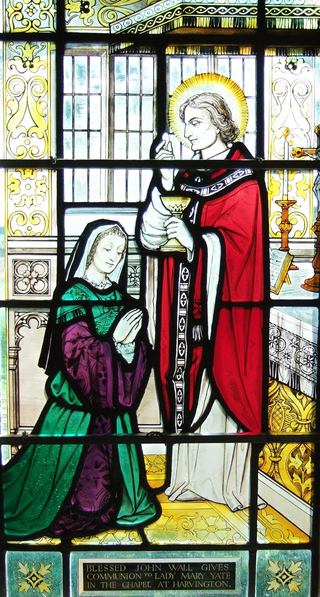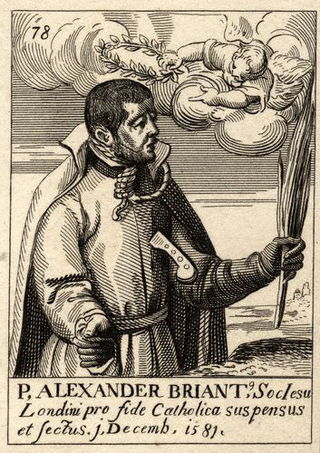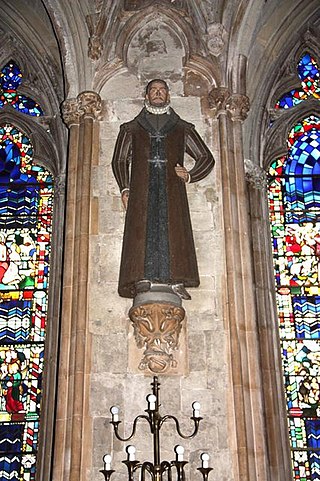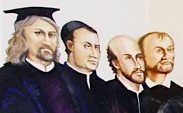
Saint John Wall,(aliases John Marsh, Francis Johnson or Dormore or Webb, religious name "Joachim of St. Ann")O.F.M., was an English Catholic Franciscan friar, who is honoured as a martyr. Wall served on the English mission in Worcestershire for twenty-two years before being arrested and executed at the time of Titus Oates's alleged plot.

The Forty Martyrs of England and Wales or Cuthbert Mayne and Thirty-Nine Companion Martyrs are a group of Catholic, lay and religious, men and women, executed between 1535 and 1679 for treason and related offences under various laws enacted by Parliament during the English Reformation. The individuals listed range from Carthusian monks who in 1535 declined to accept Henry VIII's Act of Supremacy, to seminary priests who were caught up in the alleged Popish Plot against Charles II in 1679. Many were sentenced to death at show trials, or with no trial at all.

Alexander Briant was an English Jesuit and martyr, executed at Tyburn.

John Rigby was an English Roman Catholic layman who was executed during the reign of Elizabeth I. He is one of the Forty Martyrs of England and Wales.

Clynnog Fawr, often simply called "Clynnog", is a village and community on the north coast of Llŷn Peninsula in Gwynedd, north-west Wales. It is in the historic county of Caernarfonshire. The community includes Pant Glas.

Richard Gwyn, also known by his anglicized name, Richard White, was a Welsh teacher at illegal and underground schools and a Bard who wrote both Christian and satirical poetry in the Welsh language. A Roman Catholic during the reign of Queen Elizabeth I of England, Gwyn was martyred by being hanged, drawn and quartered for high treason at Wrexham in 1584. He was canonized by Pope Paul VI in 1970 as one of the Forty Martyrs of England and Wales. Since its creation in 1987, St. Richard Gwyn has been the Patron Saint of the Roman Catholic Diocese of Wrexham. Along with fellow lay martyr St. Margaret Clitherow, Gwyn is the co-patron of the Latin Mass Society of England and Wales.

The Venerable English College, commonly referred to as the English College, is a Catholic seminary in Rome, Italy, for the training of priests for England and Wales. It was founded in 1579 by William Allen on the model of the English College, Douai.

Irish Catholic Martyrs were 24 Irish men and women who have been beatified or canonized for dying for their Catholic faith between 1537 and 1681 in Ireland. The canonisation of Oliver Plunkett in 1975 brought an awareness of the others who died for the Catholic faith in the 16th and 17th centuries. On 22 September 1992 Pope John Paul II proclaimed a representative group from Ireland as martyrs and beatified them.

Swithun Wells was an English Roman Catholic martyr who was executed during the reign of Elizabeth I. Wells was a country gentleman and one time schoolmaster whose family sheltered hunted priests. He himself often arranged passage from one safehouse to another. His home in Gray's Inn Lane was known to welcome recusants.

Eustace White was a Catholic priest. Due to his service he was put on trial in December 1591 and subsequently hanged, drawn and quartered at Tyburn on 10 December 1591, along with another priest and three laymen. He is one of the Forty Martyrs of England and Wales and has been canonised by Pope Paul VI in 1970.
A priest hunter was a person who, acting on behalf of the English and later British government, spied on or captured Catholic priests during Penal Times. Priest hunters were effectively bounty hunters. Some were volunteers, experienced soldiers or former spies.

Richard Simpson was an English priest, martyred in the reign of Elizabeth I. He was born in Well, in Yorkshire. Little is known of his early life, but according to Challoner's Memoirs of Missionary Priests, he became an Anglican priest, but later converted to Catholicism. He was imprisoned in York as a Catholic recusant; on being released, he went to Douai College, where he was admitted on 19 May 1577. The date of his ordination is unknown; the college, at this time, was preparing for its move to Rheims, and record keeping was affected. But it is known that the ordination took place in Brussels within four months of his admission to the seminary, and that on 17 September, Simpson set out for England to work as a missionary priest. He carried out his ministry in Lancashire and Derbyshire.
Robert Ludlam was an English priest, martyred in the reign of Queen Elizabeth I. He was born around 1551, in Derbyshire. His father was a yeoman. He matriculated at St John's College, Oxford, in 1575, and remained there for two or three years, but left without taking a degree. He was admitted to the English College at Rheims on 25 November 1580, and the following September, he was ordained as a priest. He set out for England on 30 April 1582.
Robert Nutter was an English Catholic priest, Dominican friar and martyr. He was beatified in 1987.
Thomas Pormort was an English Roman Catholic priest. He was beatified in 1987.
John Bodey was an English Roman Catholic academic jurist and lay theologian. He was martyred in 1583, and beatified in 1929.
William Harrington was an English Jesuit priest. He is a Roman Catholic martyr, beatified in 1929.
Oliver Lloyd was a Welsh Anglican priest and lawyer who became Dean of Hereford Cathedral.
John Talbot was an English Catholic recusant and martyr.











